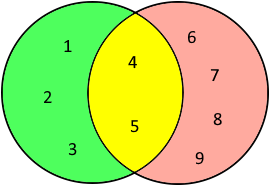Set Intersection
Calculator for computing set intersections with comprehensive formulas and examples
Set Intersection Calculator
What is calculated?
The intersection A ∩ B contains all elements that are in both set A and set B. It represents the "common" elements of both sets.
Set Intersection Info
Properties
Set Intersection A ∩ B:
- Commutative: A ∩ B = B ∩ A
- Associative: (A ∩ B) ∩ C = A ∩ (B ∩ C)
- Idempotent: A ∩ A = A
- A ∩ B ⊆ A and A ∩ B ⊆ B

Venn diagram of set intersection
Memory aid: "The intersection contains only elements that appear in both sets simultaneously."
Examples
{1,2,3} ∩ {2,3,4} = {2,3}
{1,2} ∩ {3,4} = ∅
{1,2} ∩ {1,2,3} = {1,2}
Related Operations
|
|
Set Intersection Formulas
Basic Definition
Commutative Law
Associative Law
Distributive Laws
Idempotence
Neutral Elements
Detailed Calculation Example
Example: A = {1,2,3,4,5}, B = {4,5,6,7,8,9}
Given:
- A = {1, 2, 3, 4, 5}
- B = {4, 5, 6, 7, 8, 9}
Step 1 - Check elements:
Step 2 - Common elements:
Verification:
Interpretation: The intersection contains only elements 4 and 5, as these are the only ones that appear in both sets.
Practical Application Example
Example: Shared hobbies of friends
Anna's hobbies (A):
Reading, Swimming, Cycling, Cooking, Painting
Ben's hobbies (B):
Swimming, Hiking, Cooking, Gaming, Photography
Question: What hobbies do Anna and Ben have in common?
Result: Anna and Ben have 2 shared hobbies where they can do activities together.
Set Intersection Laws
Fundamental laws of set theory
Commutative Law
Order doesn't matter
Associative Law
Grouping doesn't matter
Distributive Law
Distribution over union
Absorption Law
Absorption of union
Example for Distributive Law
Given: A = {1,2}, B = {2,3}, C = {3,4}
B ∪ C = {2,3,4}
A ∩ (B ∪ C) = {1,2} ∩ {2,3,4} = {2}
A ∩ B = {2}, A ∩ C = ∅
(A ∩ B) ∪ (A ∩ C) = {2} ∪ ∅ = {2} ✓
Mathematical Properties
Basic Properties
- Subset: A ∩ B ⊆ A and A ∩ B ⊆ B
- Commutativity: A ∩ B = B ∩ A
- Associativity: (A ∩ B) ∩ C = A ∩ (B ∩ C)
- Idempotence: A ∩ A = A
Special Properties
- Empty set: A ∩ ∅ = ∅
- Universal set: A ∩ U = A
- Complement: A ∩ Ac = ∅
- Cardinality: |A ∩ B| ≤ min(|A|, |B|)
Important Notes
Disjoint sets: If A ∩ B = ∅, then A and B are disjoint
Greatest lower bound: A ∩ B is the largest set contained in both
Practical Applications
Databases
- SQL INTERSECT operations
- JOIN operations
- Finding common records
- Overlap analysis
Social Analysis
- Mutual friends
- Overlapping interests
- Shared attributes
- Group intersections
Data Analysis
- Overlapping categories
- Common features
- Filter operations
- Correlation analysis
|
|